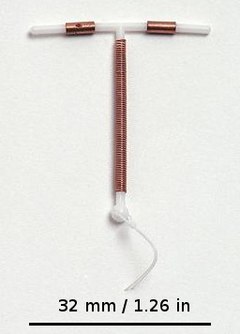
Back لولب رحمي نحاسي Arabic Měděné nitroděložní tělísko Czech Kupferspirale German Dispositivo intrauterino de cobre Spanish Ներարգանդային պղնձե պարույր Armenian IUD Tembaga ID 銅付加IUD Japanese കോപ്പർ ഐ.യു.ഡി Malayalam तांबी Marathi कप्पर टी Nepali
| Copper IUD | |
|---|---|
 Photo of a common IUD (Paragard T 380A) | |
| Background | |
| Type | Intrauterine |
| First use | 1970s[1] |
| Trade names | copper-T, ParaGard, others |
| AHFS/Drugs.com | FDA Professional Drug Information |
| Failure rates (first year) | |
| Perfect use | 0.6%[2] |
| Typical use | 0.8%[2] |
| Usage | |
| Duration effect | 5–12+ years[1] |
| Reversibility | rapid[1] |
| User reminders | Check thread position after each period. Have removed shortly after menopause, if not before. |
| Clinic review | Annually |
| Advantages and disadvantages | |
| STI protection | No |
| Periods | May be heavier and more painful[3] |
| Benefits | Unnecessary to take any daily action. Emergency contraception if inserted within 5 days |
| Risks | Small risk of PID in first 20 days following insertion.[3] Rarely, uterine perforation. |
A copper intrauterine device (IUD), also known as an intrauterine coil or copper coil or non-hormonal IUD, is a type of intrauterine device which contains copper.[3] It is used for birth control and emergency contraception within five days of unprotected sex.[3] It is one of the most effective forms of birth control with a one-year failure rate around 0.7%.[4] The device is placed in the uterus and lasts up to twelve years.[3][1][5] It may be used by women of all ages regardless of whether or not they have had children.[6] Following removal, fertility quickly returns.[1]
Side effects may be heavy menstrual periods, and/or rarely the device may come out.[3] It is less recommended for people at high risk of sexually transmitted infections as it may increase the risk of pelvic inflammatory disease in the first three weeks after insertion.[6] It is recommended for people who don't tolerate or hardly tolerate hormonal contraceptives. If a woman becomes pregnant with an IUD in place removal is recommended.[6] Very rarely, uterine perforation may occur during insertion if not done properly.[1] The copper IUD is a type of long-acting reversible birth control.[4] It primarily works by killing the sperm.[1]
The copper IUD came into medical use in the 1970s.[1] It is on the World Health Organization's List of Essential Medicines.[7] They are used by more than 170 million women globally.[8][9]
- ^ a b c d e f g h Goodwin TM, Montoro MN, Muderspach L, Paulson R, Roy S (2010). Management of Common Problems in Obstetrics and Gynecology (5 ed.). John Wiley & Sons. pp. 494–496. ISBN 978-1-4443-9034-6. Archived from the original on 2017-11-05.
- ^ a b Trussell J (2011). "Contraceptive efficacy" (PDF). In Hatcher RA, Trussell J, Nelson AL, Cates W Jr, Kowal D, Policar MS (eds.). Contraceptive technology (20th revised ed.). New York: Ardent Media. pp. 779–863. ISBN 978-1-59708-004-0. ISSN 0091-9721. OCLC 781956734. Archived (PDF) from the original on 2017-02-15.
- ^ a b c d e f World Health Organization (2009). Stuart MC, Kouimtzi M, Hill SR (eds.). WHO Model Formulary 2008. World Health Organization. pp. 370–2. hdl:10665/44053. ISBN 9789241547659.
- ^ a b Wipf J (2015). Women's Health, An Issue of Medical Clinics of North America. Elsevier Health Sciences. p. 507. ISBN 978-0-323-37608-2. Archived from the original on 2017-09-24.
- ^ "IUD Birth Control Info About Mirena & ParaGard IUDs". www.plannedparenthood.org. Archived from the original on 4 January 2021. Retrieved 22 March 2018.
- ^ a b c British national formulary : BNF 69 (69 ed.). British Medical Association. 2015. pp. 557–559. ISBN 978-0-85711-156-2.
- ^ World Health Organization (2019). World Health Organization model list of essential medicines: 21st list 2019. Geneva: World Health Organization. hdl:10665/325771. WHO/MVP/EMP/IAU/2019.06. License: CC BY-NC-SA 3.0 IGO.
- ^ Speroff L, Darney PD (2011). A Clinical Guide for Contraception. Lippincott Williams & Wilkins. p. 243. ISBN 978-1-60831-610-6. Archived from the original on 2017-11-05.
- ^ Schäfer-Korting M (2010). Drug Delivery. Springer Science & Business Media. p. 290. ISBN 978-3-642-00477-3. Archived from the original on 2017-11-05.